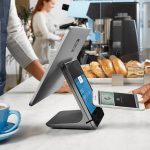More than two years after the U.S. migration to EMV chip cards accelerated, evidence of the success of the effort continues to emerge. Merchant acquirer Square Inc. says nearly 92% of the transactions it processed as of December were made with EMV-enabled credit and debit cards.
While the advent of chip cards has helped reduce counterfeit card fraud—Visa Inc. says it’s down 70% from more than two years ago—it introduced longer processing times for consumers and merchants. But Square, and others through card-brand programs, have been at work shortening chip-processing times.

A year ago, Square announced an average time of 3.6 seconds for a contact chip card transaction made in the United States with its Square Reader for chip and contactless transactions. The goal in 2018 is to reduce that even more, says Jesse Dorogusker, Square’s head of hardware. “We will definitely get under three seconds,” Dorogusker tells Digital Transactions News. “I can’t say when we’ll get there.”
San Francisco-based Square already is close to three seconds for EMV transactions on its Square Register, a point-of-sale system introduced in 2017. Square, which is not using any of the card brands’ speedier EMV protocols—Quick Chip from Visa, M/Chip Fast from Mastercard, and Discover Quick Chip—is able to whittle the time down because it controls both the hardware and software, Dorogusker says.
As an example, most EMV POS terminals are designed to readily accept any EMV-compliant chip card. While U.S. chip cards are relatively new and have modern operating systems, older cards, which are still compliant, are in use in other markets. POS terminals must be able to conduct what’s called a handshake with these cards, Dorogusker explains. In layman’s terms, the terminal and card figure what their compatibilities are and proceed with the transaction from there.
“Since we make the hardware for ourselves and the software we run only runs on our readers, we take a lot of the chattiness out,” Dorogusker says. Using that control with Square’s visibility into transactions made on its network enables the company to remove EMV use cases that never happen, he says. “The slowest part of the chip card transaction is the chattiness between the card, the reader, and the back-end service,” he says.
Contactless is even faster, Dorogusker says. Such transactions take less than a second for Square devices, he says. But contactless transactions are scrutinized, too. It can take a couple hundred milliseconds to power up an NFC system, which is typically activated after the items are loaded into the shopping cart and the purchase button is pressed. Square, because it controls the hardware and software, can power up the NFC system in advance, when it senses an item is placed in the shopping cart. That may consume a bit of power, but the tradeoff in time is worth it, Dorogusker says.






